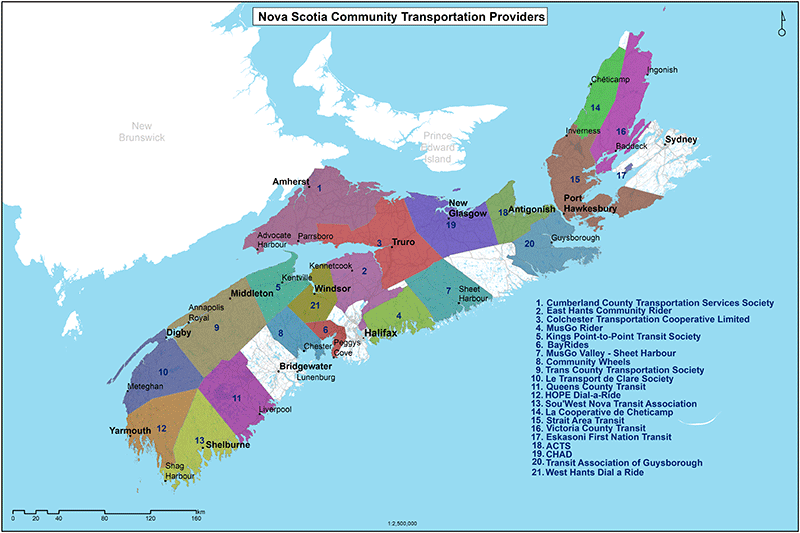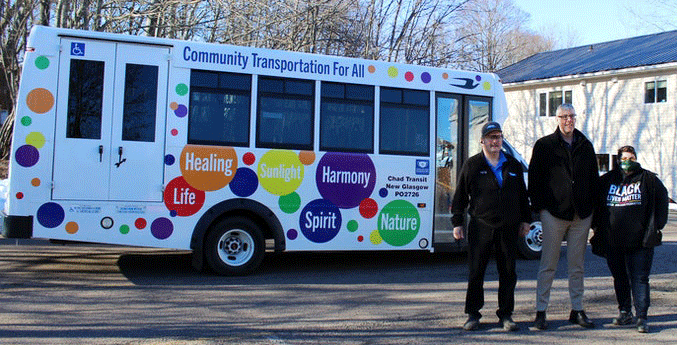Providing Equitable Transportation to Rural Nova Scotia
THE PROJECT
The Nova Scotia Community Transportation Network (Network) works with transportation providers, the Rural Transportation Association (RTA), and three levels of government to facilitate door-to-door transit service for people living in rural and remote communities across Nova Scotia.
BACKGROUND
The Network is a non-profit organization with a mission “to lead and support the development of innovative and practical solutions to community transportation challenges”. Founded in 2001, the Network now partners with 21 transportation providers that cover all but two counties in Nova Scotia.
Almost entirely surrounded by the Atlantic Ocean on the east coast of Canada, Nova Scotia is home to approximately 925,000 people. Nearly one half of its population (45%) live in the City of Halifax and many of its residents live in rural or remote communities. One in five people are over the age of 65 while about 15% are under the age of 15. In Nova Scotia, the transportation sector is the second biggest source of greenhouse gases, responsible for 33% of climate emissions.
THE PROCESS
“We don’t deliver transportation services ourselves,” explained Leslie Carlyle-Ebert, who has been working with the Network for over seven years. “We facilitate new projects, produce educational resources, and advocate to three levels of government and the community at large in support for efficient and affordable public transportation for people in remote and rural communities across the province.”

The rural transportation providers, all of whom are members of the RTA, offer community-based services. All offer local transportation within their rural or remote communities and will offer transportation between local communities and a major urban centre such as Halifax or Sydney when there is a need. Some offer direct route service, but all offer door-to-door service. All of them offer an accessible service to everyone in the community.
“The transportation services offered by our partners are used by a broad group of people in our communities,” noted Leslie. “People who cannot drive, retired people who do not want to drive in winter months, people who don’t own cars, students, and people with mobility challenges – all use these services.”
The Network is pleased to welcome two new transportation providers as partners. The last two counties in Nova Scotia without service will be coming on-board in 2022. A number of the providers serve communities with specialized cultural needs. Eskasoni First Nations, LaCabie and Transport de Clare offer culturally sensitive services that reflect the needs of their communities.
The RTA providers also have different funding sources. All receive funding from the provincial government and many receive additional funding from municipal governments, community-based fundraising, and/or corporate sponsorship. Recently, funding has also become available through the federal government’s Rural Transit Solutions Fund.
“The Network works with our transportation providers on special projects as well,” said Leslie. “For example, we did sourcing research for the application process for funding from the federal government to replace some of the vehicles in our partners’ fleets with hybrid or electric vehicles that emit fewer greenhouse gases.”

In 2021, the Network, the RTA, and their partners, collaborated with public health to help transport people in rural Nova Scotia to their COVID-19 vaccine appointments. The provincial government offered a Vaccine Fare Subsidy to support the transportation fare so that travel costs for passengers could be limited to $5 per round trip to a vaccination site within or outside their communities.
“The RTA delivered the transportation service while the Network managed it,” explained Leslie. “We worked with providers and marketing professionals to advertise the Vaccine Fare Subsidy via radio spots in English and French and with ads on social media. We also worked with provincial health services to ensure that people could learn about the service when they booked their vaccine appointments through the 811 health services telephone line.”
“The pandemic experience showed the public that there are alternative transportation options that could improve access for people in remote and rural communities in a cost-effective way,” said Leslie. “At present, people who need to get to and from hospitals for treatments can be transported in ambulances, which can be very expensive. Many of our providers are using small vans that carry 4 or 5 people that have much less impact on the environment than an ambulance, while also cutting costs.”
OUTCOMES ACHIEVED
Over 20 years, working in collaboration with the three levels of government and the RTA in Nova Scotia, the Network has helped develop transportation services for rural and remote communities across Nova Scotia.
Most communities in Nova Scotia have local community transit service with access to a nearby hub where they can access healthcare services and other essential services. The average annual ridership of all the services is 214,828. Ridership continues to grow; it even grew during the pandemic.
Transportation services are being provided to people who cannot drive because of age, ability or income in most rural and remote communities in Nova Scotia, making all levels of education, healthcare services, and other essential services more accessible to all.
Transportation services are being provided in a culturally sensitive way to a First Nation community and two unilingual Francophone communities.
During the pandemic, the Network worked with provincial health services and the RTA to ensure that people in rural and remote communities could access vaccine appointments at the flat rate of $5 per round trip; 1900 round trips were made for vaccination appointments.
While the Network has not evaluated the impact of its services on climate emissions, they believe that their partners are reducing transportation-related climate emissions by reducing the number of single-passenger vehicle trips are taken in the province, and by utilizing low-emission fuels whenever possible.
LESSONS LEARNED
Community-based transportation is essential to so many people in rural and remote communities. Without it, there are many different groups of people who are denied access to jobs, schools, healthcare services, and other essentials, because they cannot drive, do not own a car, or cannot afford a car.
If we work across sectors – community-based transportation groups, community services, and healthcare services, for example – we can find new ways of meeting the access needs of our communities in an efficient, environmentally-friendly, and cost-effective way.
Prepared by Kim Perrotta, MHSc, Executive Director, CHASE
Last modified: March 10, 2023

